 |
||
|
||
| ||
Guess what is it? 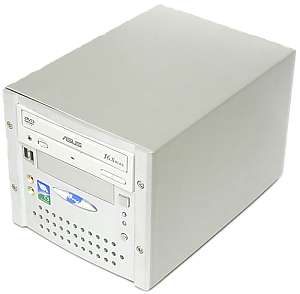 High-efficient data base server? Some kind of a Silicon Graphics work station? Nope. Look again: 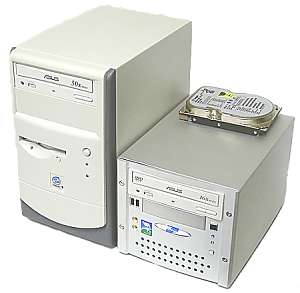 Repainted Nintendo GameCube? A compact, quiet and cheap office computer? Well, this will be the closest answer. In fact, it is a barebone system from the same class of computer systems as the ASUS Terminator. Well, a Barebone system is an almost finished computer without a processor, memory and storage devices. Or it is a case with a power supply unit and an integrated mainboard. Chassis from ShuttleThe case itself is quite small: 27X19X17 cm, made of aluminum and is rather weighty.  As you can see it has a 16x DVD-ROM from ASUS and a lot of connectors. On the front panel there are only two pairs: Line In and Line Out and two USB. 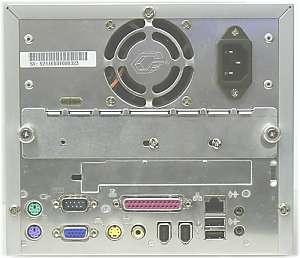 The rear panel has them more. From left to right: connectors of PS/2 ports of keyboard&mouse, a serial port and VGA, S-Video and Composite Video (for TV-Out), a parallel port, two Firewire, mains and one pair of USB with Line In/Line Out. A bit higher there is one more hidden output for one expansion card. Now let's open it. 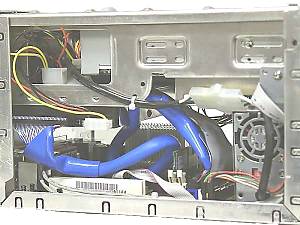 Well, it is not a bigtower and not even a Terminator. Now this box seems to be quite light :) It is really not heavy because of dimensions and material of the case (the case itself weighs 2.4 kg). Let's leave aside the stuff like a hard drive (Seagate Barracuda ATA IV), a CD/DVD-ROM drive (16x DVD-ROM ASUS), a FDD (absent this time) and memory (128 MBytes PC133 SDR SDRAM Kingston) - as you remember, they are not included in the barebone system, - and take a look at the FV24 board from Shuttle based on the VIA PL133 chipset. I think it is unnecessary to give here detailed characteristics of this chipset; just look at an equation: PL133 =Apollo Pro133A + Savage4. The mainboard has a lot of integrated things, for example, an AC'97 Audio codec from VIA (VT1611A). The form-factor of the board is FlexATX (19X17 cm) and the board supports Intel Pentium III/Celeron and VIA C3 processors with FSB 66/100/133 MHz. Engine from VIATo start the system we need a processor. Let's see what we have and which processor will be the best solution for this system. So, we have a small case with a supply unit of 145 W (equipped with a little quiet fan), three bays for storage devices (it is interesting that a hard drive is first put into a box and then pushed into the system block from behind) and one PCI slot. The performance of an integrated video solution as we consider shouldn't be high, that is why such a system will hardly please hard-core gamers. So, I think that the VIA C3 that doesn't consume much energy is the best choice for this system. The power supply unit, thus, won't be overloaded and a noise level won't be too high as the processor can work without a fan (but not without a heatsink!). The whole positive bundle of features peculiar to the old C3 on the Samuel2 remained and multiplied in the new Ezra based on the 0.13 micron process. As a result of the new fab process, the core works at a higher frequency (the starting one for the C3 Ezra is 800 MHz, while in the C3 Samuel2 line 800 MHz was the highest) and supply voltage is lower (1.35 V for the Ezra against 1.6 V for the Samuel2). Therefore, dissipated power is now also lower. The tested device is equipped with the latest model working at 933 MHz. 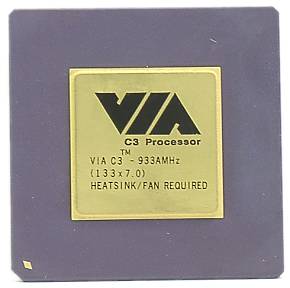 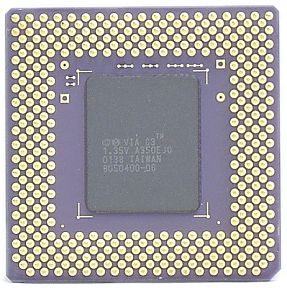 Go!So, what is this wonder able to do? The marketing department says the following: 1. Office use: work with electronic documents and the Internet, operation in a local network. Here everything is OK: the network controller (10/100 base-T) works and the performance in typical business applications is quite high:
2. Home multimedia system: simple PC operation, work on the Internet, music, video and DVD playback. Almost all advantages of the Shuttle SV24 are enabled here: an elegant appearance, small dimensions, quiet operation, low power consumption. The computer copes with all the mentioned tasks (though with one DVD disc an image froze from time to time). The CPU utilization during playing DVD was around 75%. One more area of utilization of the device is digital video editing (remember the Firewire ports?). The idea is moot, but it is meant for "enthusiasts of home digital video"... To prove that it's impossible to step aside we give you the results of the Quake3:
Well, the Cube is really not for games. 3. Compact and economical server for operation in racks. The data on dimensions and power of the supply unit were given above, so you can draw a conclusion yourselves as the subject is specific. 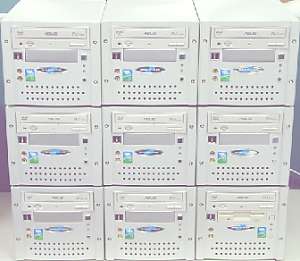 In closing, some words on the temperature mode. During the tests the case was closed, the C3 processor was cooled down with a big heatsink; besides, there are such heat sources as the supply unit, the hard drive (Seagate Barracuda ATA IV which warms up considerable) and the DVD-ROM drive. When we played DVD discs the temperature of the processor controlled by the internal sensor easily raised from 39° to 55°, the rotating speed of the big fan of the case got higher and the case was warm. The operation was stable enough, and there was a considerable reserve for decreasing the temperature which, however, must be paid for by a higher noise level. Arrived?As expected, the Shuttle SV24 barebone systems will be supplied to OEMs, as well as to end-users. I hope you now understand what this system is targeted at. And now I want you to come back to the beginning
of the article and clarify whether this system is a compact, noiseless
and cheap office computer. Well, there is only the latter item left
to be discussed. So, the recommended retail price of the Shuttle
SV24 Barebone is $250. The quality of the product is really high,
but I doubt that anyone of DIY assemblers would want to get the
Shuttle SV24 at such a price. Well, at least, you can admire the
photos.
Write a comment below. No registration needed!
|
Platform · Video · Multimedia · Mobile · Other || About us & Privacy policy · Twitter · Facebook Copyright © Byrds Research & Publishing, Ltd., 1997–2011. All rights reserved. |